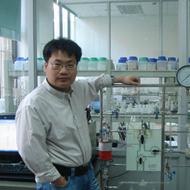Atomically Engineered Active Sites for Photocatalytic Hydrogen Evolution Reaction
SEMINAR
The State Key Lab of
High Performance Ceramics and Superfine Microstructure
Shanghai Institute of Ceramics, Chinese Academy of Sciences
中 国 科 学 院 上 海 硅 酸 盐 研 究 所 高 性 能 陶 瓷 和 超 微 结 构 国 家 重 点 实 验 室
Atomically Engineered Active Sites for Photocatalytic Hydrogen Evolution Reaction
Speaker
杨化桂 教授
华东理工大学
时间:2015年11月24日(星期二)下午 14: 00
地点: 2号楼607会议室 (国家重点实验室)
欢迎广大科研人员和研究生参与讨论!
联系人:施剑林(2712),步文博(2610)
 报告人简介:
报告人简介:
杨化桂:华东理工大学,博士、教授、博士生导师,曾任澳大利亚昆士兰大学名誉教授、格里菲斯大学兼职教授。已先后入选“东方学者”特聘教授、上海市优秀学术带头人、上海市“曙光学者”、教育部“新世纪优秀人才”等人才计划。长期从事太阳能转换与存储领域的研究,包括人工光合成作用及新型光伏技术中关键材料的理性设计、可控制备及机理探索。迄今作为第一或通讯作者,已在Nature、Nature Commun.、Angew. Chem. Int. Ed.、J. Am. Chem. Soc.等国际学术期刊发表论文100余篇,所发表论文被SCI他引次数达5800余次,单篇他引最高达1500余次,H指数为32。参与完成并获教育部自然科学奖一等奖1项,二等奖1项,上海市自然科学奖一等奖1项;主持国家自然科学基金等十余个项目;获授权国际发明专利3项,申请中国发明专利7项。研究工作多次得到专业期刊或新闻媒体如Nature Materials,Chemical & Engineering News,Chemistry World,科学通报,新华网,中国科学报,The Courier Mail, The Australian, The Age, The Sydney Morning Herald, ABC Radio 等报导,获得国际同行的积极评价,并多次受邀在国际学术会议做邀请报告。兼任上海硅酸盐学会理事、上海硅酸盐学会新能源材料专业委员会主任委员。
报告摘要:
The growing energy crisis and environmental issues are driving the development of clean and sustainable energy sources. In particular, solar energy as one of the best sources of renewable energy has attracted significant attention as a promising way to solve these problems. Herein, we studied various atomically engineered catalytic materials to enhance the solar-driven water splitting. First of all, using polymer ligands to control the size and valence state of platinum monoxide clusters, we found that Pt in a higher oxidation has remarkable hydrogen oxidation reaction suppression ability, while its H2 evolution capacity is still comparable to that of the benchmark of conventional Pt cocatalyst.[1] Moreover, we explored the active sites of Pt/TiO2 photocatalyst on atomic level by a collaborative analysis from both experimental and theoretical work; metallic Pt0 nanoparticles have little contribution to the activity of solar water splitting and by contrast, oxidized species Ptδ+ truly take the role of the catalytic active sites.[2] In addition, we designed and synthesized a surface H-bonding network decorated g-C3N4 photocatalyst with high efficiency of visible-light-driven H2 production. According to NMR and theoretical modeling, the H-bonding bridge can effectively shorten the distance between water molecules and g-C3N4, provide multiple channels for the transition between protons and the excited electrons on g-C3N4, stabilize the anionic intermediate and transition states, and restrain charge recombination.[3] Furthermore, we anchored isolated Pt atoms on TiO2 and this photocatalyst exhibits a high solar-driven hydrogen evolution performance compared with Pt nanoparticles or clusters. The configurations of the isolated Pt atoms and their catalytic hydrogen evolution activity were calculated by large-scale periodic DFT analysis.[4] Additionally, we found that the photoreactivity of hydrogen generation can be correlated with the cluster size of the oxidized platinum cocatalyst as function, and the maximum turnover frequency is found on the smallest-sized cocatalyst.[5] These results would open a door for rethinking of the detailed principles of photocatalysis, and may also stimulate novel ideas for the design and optimization of heterogeneous photocatalysts.
References:
[1] Y. H. Li, J. X., Z. J. Chen, Z. Li, F. Tian, H. G. Yang*, Nature Commun., 2013, 4, 2500.
[2] J. Xing, H. B. Jiang, J. F. Chen, Y. H. Li, H. G. Yang*, J. Mater. Chem. A, 2013, 1, 15258. (Cover story)
[3] X. L. Wang, W. Q. Fang, H. F. Wang, H. G. Yang*, J. Mater. Chem. A, 2013, 1, 14089. (Cover story)
[4] J. Xing, J. F. Chen, Y. H. Li, W. T. Yuan, H. G. Yang*, Chem. Eur. J., 2014, 20, 2138. (Cover story)
[5] Y. H. Li, J. X., X. H. Yang, H. G. Yang*, Chem. Eur. J., 2014, 20, 12377.


 当前位置:
当前位置:

